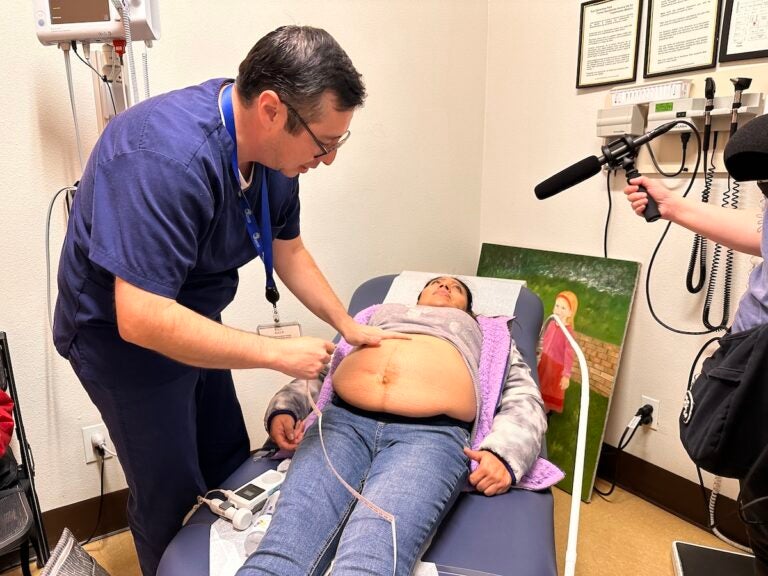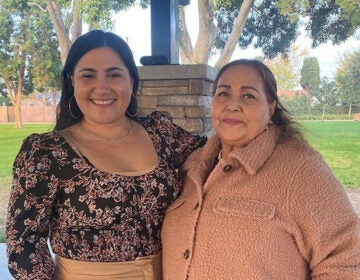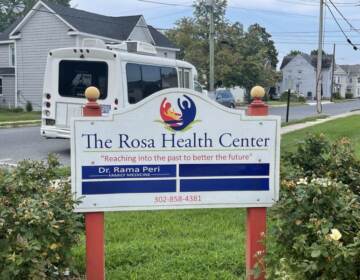One bold initiative to recruit Mexican doctors to help bridge language barriers back home
A physician and policy expert team up on a decades-long effort to bring Spanish-speaking doctors to California — and the roadblocks that stood in their way.
Listen 25:11
Dr. Armando Moreno performs an ultrasound on a patient at the CSVS Gonzales Clinic. (Mayra Pantoja)
This story is from The Pulse, a weekly health and science podcast.
Find it on Apple Podcasts, Spotify, or wherever you get your podcasts.
Max Cuevas didn’t have it easy growing up. His family, along with all the families he knew, made a living doing backbreaking work in the fields of Lindsay, California.
“You’re carrying about a 70-pound sack that you’re filling with either oranges or lemons and you’re climbing up and down a ladder. Once it’s filled, then you go dump it, and then the process starts again,” described Cuevas.
He and his eight siblings would go to school during the week, then on the weekend, they’d work with the family. The same went for vacations. Christmas, Thanksgiving, New Year’s, they’d be out in the fields.
During the colder months, they’d pick oranges and lemons. Then, as soon as summer break started the whole family would pack up their car and drive to San Jose to live in tent camps picking cherries, apricots, and pears. In August, they’d drive south to Fresno for the grape season before returning to Lindsay to catch the start of school and the next orange season. This was the cycle, year in and year out.
Tragedy inspires Cuevas
The work was tough, but this Mexican American family was tight and spent their days laughing and joking together in Spanish.
However, tragedy struck in 1962 when one of Cuevas’s brothers fell sick. He was prescribed penicillin and had a severe allergic reaction. A few days later, he died. The whole family was devastated.
Cuevas recalls the pain.
“Seeing the hurt and the crying, it was inconsolable. I could see it in my mom and dad, my grandmother, my other brothers, and sisters, and I thought, ‘If I can become a physician, maybe it’ll make a difference.’”
That day, Cuevas decided that he would become a doctor and started paying more attention to the health issues of his community.
Subscribe to The Pulse
One day, at a tent camp in San Jose, he overheard a woman talking about her sickness. She was suffering from pain in her mid-section and brought her daughter along to translate to the doctor.
She told her daughter she had, “dolor del bazo,” pain of the spleen, but the girl didn’t know the word for spleen in Spanish, “bazo.” Instead, she understood “vaso,” which means glass, and so pain of the spleen, “dolor del bazo” became “dollar del vaso” or a dollar in the glass.
The doctor was lost and couldn’t help the mother.
Two similar paths about to cross in a big way
Just a few towns away from where Cuevas was living in California, another young Mexican American boy named Arnoldo Torres was having a similar experience.
“My grandfather told me that I was of the age in which I had to do la cosa Cristiana, the Christian thing. And I asked him, ‘Papi, what is that?’ And he says, ‘you have to contribute to the well-being of the family. You have to work,’” recalled Torres.
Torres had his mind set on going to college, and after getting a bachelor’s degree in political science, he went far away from home to Washington DC where he pursued a master’s degree in public policy.
Meanwhile, back in California, Max Cuevas attended medical school, became an OBGYN, and took a job as the chief medical officer at a little health clinic in Salinas, California called Clinica de Salud del Valle de Salinas. There he served a farm-working community just like the one he had grown up with.
The Salinas Valley where the clinic was located, produces a huge amount of the fruits and vegetables we eat, and because of this it has one of the highest populations of farmworkers in the whole country.
Arnoldo Torres came back to California to advise local health clinics, and this is when he and Cuevas finally met. There was an instant connection between the two men.
Torres recalls, “He and I were drawn to each other because we both worked in the fields. There was a very special bond. There’s a solidarity between us because of these experiences as children growing up in the same kind of environment.”
NAFTA causes a flood of migration
In 1993 something happened that would change the fabric of these communities and bring Cuevas’ clinic to a breaking point. NAFTA, the North American Free Trade Agreement, removed the trade tariffs between Mexico and the United States.
This opened the door for heavily subsidized U.S. Agriculture companies to export their crops south of the border below cost in the Mexican market. The result was devastating. Many local Mexican farmers lost virtually all their income and came to the U.S. to try and scrape together a living in the fields.
The clinic where Cuevas worked became overwhelmed as more and more farm workers came from Mexico speaking Spanish and indigenous languages. There were nowhere near enough doctors who knew the languages or the culture.
Cuevas and Torres go on a mission
Torres and Cuevas decided they had to do something. So, in 1997 with the problem growing even worse, Torres came up with a wild plan.
“The only avenue that we had was to go outside and see if we could bring doctors in,” Torres said.
He wanted to create a program that would allow Mexican doctors to work in the U.S. for 3 years, in areas that so desperately needed Spanish-speaking doctors.
It was not a simple proposition, to make it happen would require agreements between the U.S. and Mexican governments, California’s medical board, Mexican universities, and the California medical school system. It seemed impossible. But without any other options — they pressed ahead.
“I knew it was going to be a formidable initiative because of who we had against us, which was everybody, I mean, everybody,” Torres said.
Cuevas said, “I was surprised by Latino physicians and Latino physician groups that were against the program. In fact, one of them dubbed the program a ‘Mexican Bracero Doctor Program.’”
But after 3 long years of meetings and advocating, Bill AB1045 cleared the California legislature and was signed into law by then Governor Gray Davis in September of 2002.
Because there were fears about Mexican doctors not being up to par, the bill specified that there would be an orientation program from the UC medical schools to help them integrate into the U.S. medical system. In the end, the schools didn’t agree to cooperate.
“We could not implement it because there was no UC medical school that wanted to cooperate. It just languished,” said Torres. “Oh, the anger, the frustration, all the suffering that our population is going through because they can’t access medical care.”
The program was put on hold, months turned into years, and time went on, but the farmworkers still toiled. They still got sick. They still couldn’t understand doctors — and they still suffered.
By 2015, Cuevas’ clinic in Salinas was completely overwhelmed, so he picked up the phone and made a call to his old friend.
They decided to give their effort one more shot. But this time, they decided to work with a local hospital for the orientation program. They chose The Natividad Medical Center right next door in Salinas.
The doctors arrive
In early August 2021, the first of 30 Mexican doctors who’d been approved got on a plane and flew to California.
Armando Moreno, an OBGYN from Mexico City, remembers his first day on the job.
“I was really scared to be honest. I was really scared.”
But Moreno started to see just how much patients appreciated being spoken to in their language.
“You build this bridge between you and your patient. There’s a lot of mutual understanding, like this empathy. There’s a subconscious communication between people from the same culture,” Moreno said.
Blanca, a Spanish-speaking patient who we are only using her first name to protect her privacy, shared how difficult it had been to communicate with doctors and what a huge relief it was to find Clinica de Salud del Valle de Salina.
“To make simple appointments — it was really hard at first. But now, I feel like a fish in water here because there’s always someone that will answer in Spanish,” she said.
The doctors at CSVS have created such a level of trust with their Spanish-speaking patients that some started opening up about more than just physical ailments.
“I’ve heard terrible, terrible stories about crossing the border, crossing the Guatemala-Mexico border. I mean, people struggle so much to be here,” Moreno said.
As an OBGYN, he sees many women who faced sexual assault during their journey. Teenagers tell stories of being separated from their parents. Women and men opening up about abuse, depression, and anxiety in their lives.
“I think that it’s this opportunity we have to try to help them, to open their hearts and to speak openly about it. This is the first step for healing,” Moreno said.
Today, there are 30 doctors in the program, each of them will serve for 3 years and be able to help hundreds of Spanish-speaking patients before returning to Mexico. The goal is to have even more doctors, dentists, and psychiatrists take part in the program in the coming years. An updated version of the bill aims to have over 200 doctors by 2036.
However, it’s important to note that while AB1045 is making a huge impact in people’s lives, the scope of the problem is too big for one program to handle.
“It’s a band-aid. It was never intended to be the answer. It was intended to provide time for the UC system to take on greater responsibility,” Torres said.
The scope of the problem is huge, and this program can’t fix everything, but for Cuevas, Torres, and all the Mexican doctors, there is a victory in every single visit where a person who felt alone, can see that they have someone on their side.
As these Mexican doctors are learning, the need to be understood is what beats at the heart of human health.
WHYY is your source for fact-based, in-depth journalism and information. As a nonprofit organization, we rely on financial support from readers like you. Please give today.






